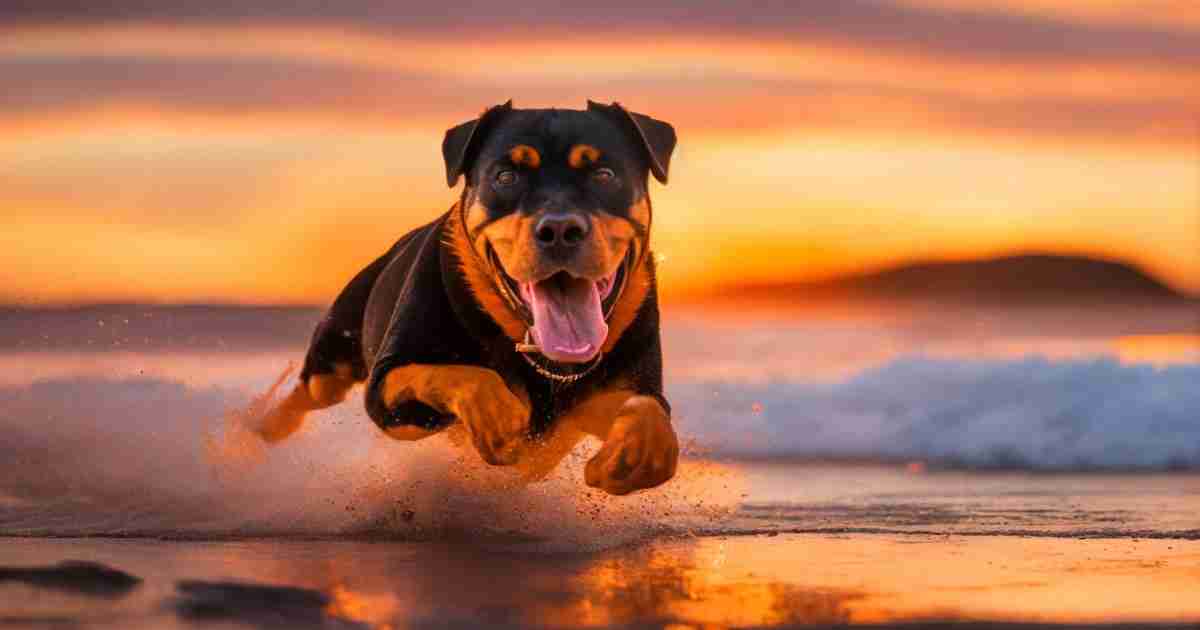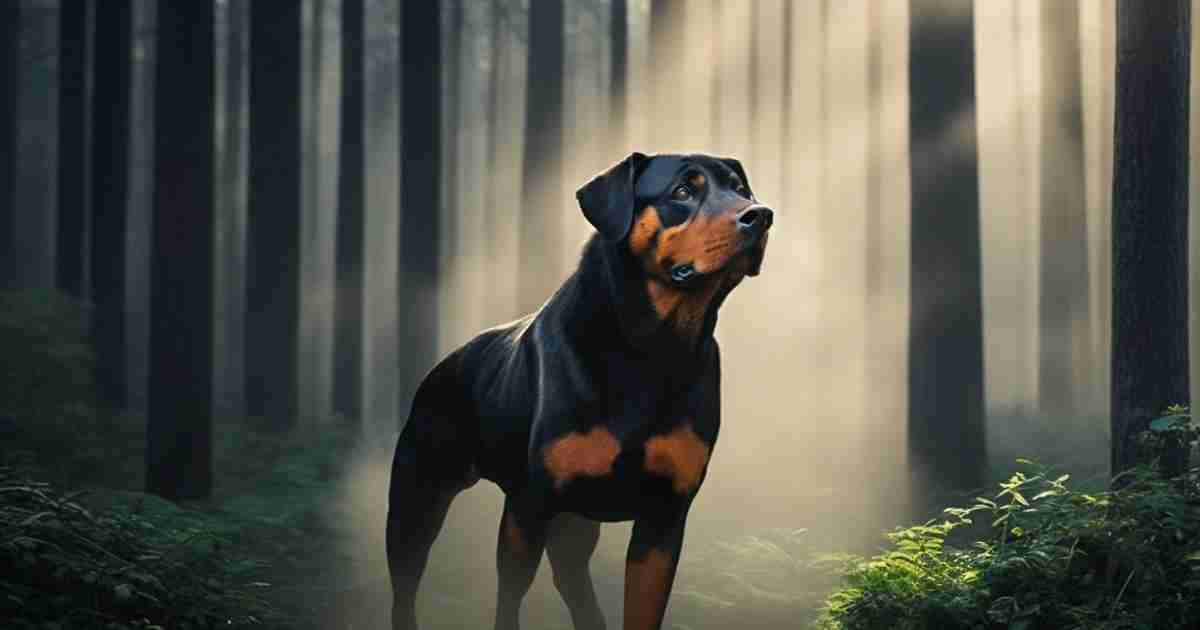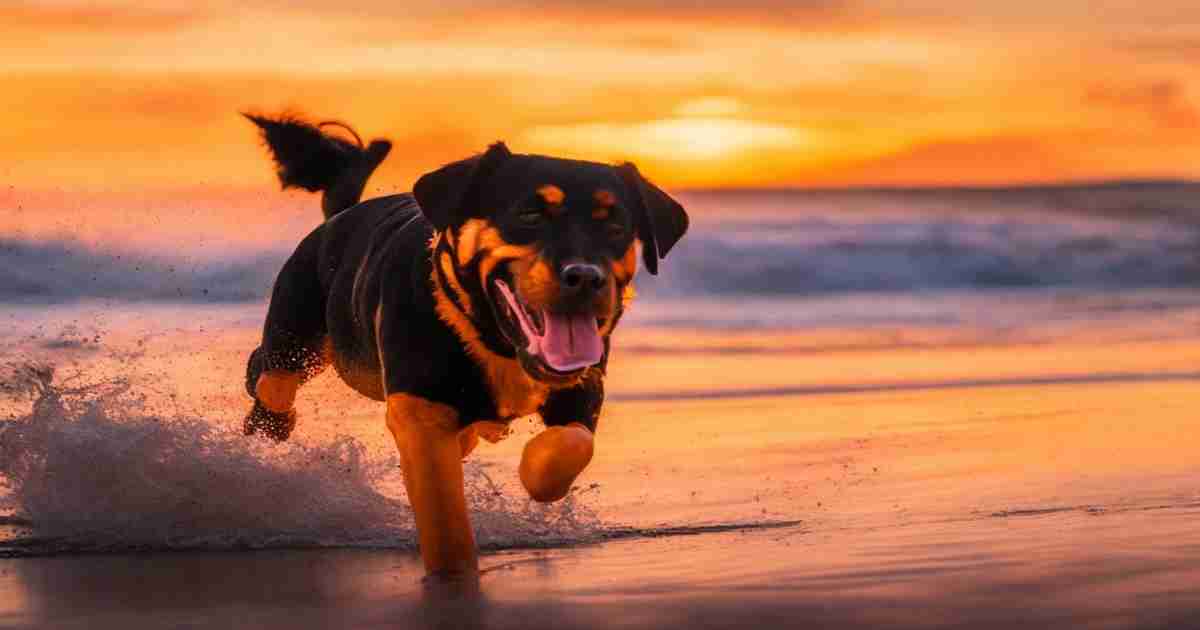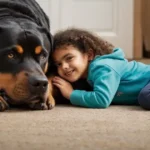As someone who loves big, goofy dogs, I was immediately smitten when I first learned about Rottweiler Labrador mixes. These so-called “designer dogs” blend the best traits of two popular purebreds to create an energetic, family-friendly canine packed with personality.
Like many folks, I was curious about what to expect from this mixed breed in terms of size, weight, height and other physical characteristics. How big do Rottweiler Labs actually get? Are there major differences between males and females? Does coat color impact size?
This article will cover everything you need to know about Rottweiler Lab mix size, from their origins as working dogs to standard measurements, common health considerations, and more. I’ll also answer some frequently asked questions about these lovable Labrotties.
Whether you’re considering adding one of these large and active dogs to your home or just want to learn more about this increasingly popular Rottweiler Lab mix, read on to get the complete guide to their size, weight, height and overall physical attributes!
Key points I’ll be covering include:
- Background on the Labrador and Rottweiler breeds
- Typical height and weight ranges
- Factors impacting size variance
- Other physical traits like coat, ears and coloring
- Behavioral traits and temperament
- Health and care considerations
- Answers to common FAQs about Rottweiler Lab size
Let’s start from the beginning and explore where these designer dogs came from in the first place!
Rottweiler Lab Mix Origins and History
Let’s go back in time and explore where these popular Rottweiler Lab mixes came from. Understanding the background of the parent breeds helps explain why Labrotties exhibit certain size, appearance and personality traits.
All About the Labrador Retriever
The friendly, family-oriented Labrador Retriever has been America’s most popular breed for years. Originally from Newfoundland, Canada, Labs were bred to help local fishermen retrieve fish and escaped catch. Their love of water, stellar swimming skills and soft “retriever” mouths made them the perfect dogs for the job.
Over time, these hardworking pups became favored gun dogs in Britain, tasked with flushing and retrieving waterfowl shot down during hunts. Labradors were imported to England in the 1800s and refined into the breed we know and love today.
Some key traits of these lovable dogs include:
- Height:5-24.5 inches (males and females)
- Weight:55-80 pounds (males), 45-70 pounds (females)
- Coat:Short, dense and water-resistant
- Coloring:Black, yellow or chocolate
- Temperament:Friendly, intelligent, energetic
So in summary, the Labrador is a medium-to-large, sturdy retriever prized for its cheerful nature and strong work ethic.
All About the Rottweiler Lab Mix Size
Rottweilers have a very different heritage than the friendly Lab. Thought to be descendants of ancient Roman drover dogs, Rotties were used to herd livestock for the Roman legions as they traveled Europe.
Their size, strength and endurance made them excellent at guarding and driving cattle. Even after the Roman empire faded, these dogs continued working as butcher’s helpers and cattle dogs in Germany.
Here are some key facts about this powerful breed:
- Height:22-27 inches (males and females)
- Weight:85-135 pounds (males and females)
- Coat:Short, dense and coarse
- Coloring:Black with tan/mahogany markings
- Temperament:Confident, courageous, strong-willed
In summary, the Rottweiler is a robust, intimidating guard dog that is eager to work and please its owner.
When Rottweilers Met Labs: The Origin of Labrotties
By the 1990s, interest in “designer dogs” hit an all-time high. People loved the idea of combining favorite purebreds into perfect blended breeds. The Rottweiler Lab mix was likely inevitable with such sought-after parents.
Labrottie breeders hoped to blend the friendly, high-energy nature of the Lab with the strength and protectiveness of the Rottweiler. And they succeeded!
Today’s Rottweiler Lab mixes embody some of the best traits from each breed. These pups are smart, loyal and energetic with a streak of natural protectiveness. Their size and weight varies, but they usually fall somewhere between the Lab and Rottie ranges.
While not purebreds, Labrotties make wonderful family pets and companions for active owners. Let’s look more at their typical physical traits and measurements.
What to Expect: Size and Physical Characteristics
Now that we’ve covered the history of Rottweiler and Labrador breeds, let’s dive into what to expect in terms of size and other physical traits from a Rottweiler Lab mix.
As we learned earlier, the Lab and the Rottie fall on opposite ends of the size spectrum when it comes to purebred dogs. Labrotties can land anywhere in between.
Rottweiler Size and Appearance
The Rottweiler is a large, stocky breed with an intimidating presence. Here are the standard measurements:
- Height: 22-27 inches shoulder height for males/females
- Weight: 95-135 pounds for males; 80-100 pounds for females
- Coat: Straight, coarse, dense and short
- Coloring: Black base with rust to mahogany markings
- Ears: Triangular, hanging forward
- Tail: Docked (US); natural, extended (UK)
As you can see, Rottweilers are substantial, powerful dogs ranging from about 80-135 pounds as adults. Their blocky heads, stocky build and muscular frame allow them to tackle tough tasks like herding cattle.
Labrador Size and Appearance
In contrast to the heavyset Rottweiler, Labrador Retrievers have a more refined, athletic build:
- Height: 21.5-24.5 inches shoulder height for males/females
- Weight: 55-80 pounds for males; 45-70 pounds for females
- Coat: Short, straight, dense and water-repellent
- Coloring: Black, yellow or chocolate
- Ears: Hanging, wide at base
- Tail: Otter tail; wide at base and tapers
Labs are medium-large dogs ranging between about 45-80 pounds fully grown. Their friendly face, floppy ears and wagging “otter tail” give them an approachable look. A water-resistant coat and webbed feet allow them to excel at swimming.
What to Expect with a Rottweiler Lab Mix
Given the size difference between the parent breeds, Rottweiler Lab mixes can vary quite a bit in stature.
Labrotties usually end up smaller than a purebred Rottweiler but larger than the average Lab. Their ideal size is often compared to a large Labrador.
Some key points about Rottweiler Lab mix size:
- Height: 22-27 inches shoulder height for males/females
- Weight: 70-115 pounds for males and females
- Larger than a Lab, smaller than a Rottie on average
- Size depends on parents’ traits and which genes are inherited
In addition to size, coat color varies quite a bit in Labrotties:
- Black, brown/chocolate, yellow or gray
- Solid or bi-color
- Rottweiler-like black and tan pattern
Labrotties tend to have the Rottweiler’s broad head and thick-set body paired with the Lab’s longer muzzle and floppy ears. Their tails can be either straight or curled.
As you can see, there’s no set standard for Rottweiler Lab mix size or appearance – every puppy is unique! Next let’s look at specific height and weight ranges.
Standard Measurements: Height and Weight Ranges
Now let’s get more specific when it comes to typical Rottweiler Lab mix size measurements for height and weight.
While there’s variance depending on the individual dog’s genetics, we can look at published ranges for these large and active designer dogs:
Rottweiler Lab Height
- Males: 22-27 inches shoulder height
- Females: 22-25 inches shoulder height
As you can see, male Labrotties are on the higher end of the standard Lab height (max 24.5 inches), while females reach about the middle of the Lab range.
Compared to Rottweilers, the Rottweiler Lab mix averages a bit shorter in stature.
Rottweiler Lab Weight
When it comes to weight, these sturdy dogs tip the scales as follows:
- Males: 70-115 pounds
- Females: 70-100 pounds
Again, male and female Labrotties fall right between the average weights of their Lab and Rottweiler parent breeds.
They outweigh most Labs, who range from 45-80 pounds fully grown, but don’t quite reach the size of a very large Rottie.
Outlier Measurements
While the above reflects the normal size range for most Rottweiler Lab mixes, some dogs fall outside of these averages:
- Some males may reach 130 pounds or more – similar to giant purebred Rottweilers
- Occasional females may stay quite petite at 55-60 pounds
- Unusually tall males could hit 30 inches shoulder height
- Shorter females might max out at just 20 inches tall
As you can see, there’s a fair bit of diversity when it comes to Rottweiler Lab mix size! While most fall within the standard ranges, your specific puppy could be an outlier.
Proper nutrition and exercise can help your dog reach a healthy weight, but their final adult size and stature also depends on the genetic lottery.
Next let’s switch gears and talk about temperament and common personality traits of these lovable designer dogs!
Behavioral Traits and Temperament
While size and appearance may vary in Rottweiler Lab mixes, their personality and temperament also depends a lot on which parent they take after. Let’s look at common behavioral traits and training considerations for these lovable dogs.
Personality Traits
As we learned earlier, Labs were bred as friendly, energetic retrievers, while Rottweilers lean towards being aloof, courageous guard dogs.
Labrottie pups can inherit personality traits from either parent, including:
Labrador Traits:
- Friendly, outgoing, eager to please
- Intelligent and highly trainable
- Gentle and patient, especially with children
- Active, energetic, loves games/activities
- Generally trusting of strangers once socialized
Rottweiler Traits:
- Confident, alert and intuitive
- Protective instincts; wary of strangers
- Intelligent but strong-willed
- Calm and dignified
- Aloof or standoffish with unknown people/dogs
Since designer dogs are a mixed bag, temperament will vary from pup to pup. Some take more after the friendly Lab, while others lean towards being reserved protective watchdogs like the Rottweiler.
With early socialization and training, most Rottweiler Lab mixes become loyal, pleasant family companions.
Training Considerations
These high-energy, intelligent dogs need significant exercise and mental stimulation. Plan on providing:
- At least 60-90 minutes of activity per day
- Opportunities to run/play in open spaces
- Challenge their brain with interactive puzzle toys and training
- Socialization from an early age to encourage friendliness
Labrotties respond best positive reinforcement training and do well with structured obedience practice. Their size and strength require behavior management if they aren’t trained properly.
Rottweiler Lab mixes generally love people but can be cautious around strangers. Take precautions when introducing new adults or children, and teach kids how to politely interact with them.
With the right blend of exercise, training and socialization, these dogs make wonderful active family companions while maintaining their natural watchfulness.
Next let’s go over some of the health considerations for large designer dogs like the Rottweiler Lab mix!
Health and Care Considerations
Rottweiler Lab mixes are generally healthy dogs, but there are some health issues to be aware of. Let’s look at grooming, diet, exercise and vet care for these large, active pups.
Grooming
Thanks to their short-haired coats from both parent breeds, Labrotties are relatively easy keepers when it comes to grooming:
- Brush 1-2 times per week to control shedding
- Bathe occasionally or as needed
- Check/clean ears to prevent infections
- Trim nails every 1-2 months
Their moderate shedding can be managed with regular brushing. A slicker brush or shedding blade helps remove loose hair.
Feeding
These energetic dogs need quality food to fuel their activity levels and maintain a healthy weight. Feed a high-protein dog food formulated for large breeds.
- Puppies need 3-4 meals per day
- Adults do well with 2 meals daily
- Portion control is important to prevent obesity
Avoid bloat by not exercising vigorously right before or after eating. Split food into smaller meals when possible.
Exercise
Rottweiler Lab mixes thrive on exercise! Plan to provide:
- At least 60 minutes of activity per day
- Off-leash play in a safe area
- Games of fetch to satisfy their retrieving instincts
- Interactive toys that provide mental and physical exercise
Regular activity will keep your Labrottie fit and happy.
Health Concerns
Some potential health issues to be aware of include:
- Joint problems like hip and elbow dysplasia
- Eye conditions such as cataracts
- Heart disease
- Bloat
Vet checks and early treatment can help manage many conditions. Discuss any specific health concerns with your breeder.
With proper care, these lovable designer dogs can live a full life and make an excellent addition to an active family!
Next up, let’s go over some frequently asked questions about Rottweiler Lab mixes.
Frequently Asked Questions
Let’s wrap up with answers to some common questions about Rottweiler Lab mixes!
At what age is a Rottweiler Lab mix fully grown?
Most Labrotties reach their adult size by 12-18 months old. They may continue filling out up to age 2.
How big of a yard/space does a Rottweiler Lab mix need?
These energetic dogs need room to run! A house with a spacious fenced yard is ideal. Apartments can work with enough daily exercise.
Are Rottweiler Labrador mixes good with kids/other pets?
When socialized early, most get along great with kids and other pets. Supervise young children and teach proper interaction.
How much exercise does a Rottweiler crossed with a Lab need daily?
Plan on 60+ minutes of vigorous activity like running, swimming, hiking each day. Retrieving games are great too.
What health problems are common in Rottweiler Lab mixes?
Joint dysplasia, eye issues, heart disease and bloat are some concerns. Ask the breeder about specific health screens.
What is the life expectancy of a Lab crossed with a Rottweiler?
The average lifespan is 9-12 years. Provide excellent nutrition and vet care for maximum longevity.
How much food should I feed my Lab Rottweiler mix puppy/adult?
Puppies need 3-4 small meals daily. Adult portions depend on size, but 2 cups is a starting point.
I hope this guide gave you a comprehensive overview of what to expect from a Rottweiler crossed with a Lab! Let me know if you have any other questions.
Conclusion
I hope this guide gave you a comprehensive overview of Rottweiler Lab mix size, appearance, temperament and ideal care for these popular designer dogs!
Here are some key takeaways:
- Labrottiesare a cross between two very different pure breeds – the friendly Labrador Retriever and the protective Rottweiler
- Their sizecan vary quite a bit, but most fall between the size ranges of the parent breeds
- Typical heightis 22-27 inches at the shoulder; weight is 70-115 pounds
- Beyond size, appearanceand temperament varies from pup to pup
- With proper socialization and training, most become great family pets
- Daily exerciseand mental stimulation is a must for these energetic dogs
- Monitor for health issues like joint problems, eye disease and bloat
While a bit unpredictable compared to pure breeds, Rottweiler Labrador mixes offer the best of both worlds – an affectionate, high-energy companion that doesn’t quite require as much space as a full-sized Rottweiler.
Their loyalty and natural watchfulness can make them excellent family guardians. If you’re up for an active pup with plenty of exercise needs and training requirements, I highly recommend this popular large crossbreed!
Let me know if you have any other questions about these amazing designer dogs. I’m happy to chat more about finding and raising the perfect Rottweiler Lab mix.









